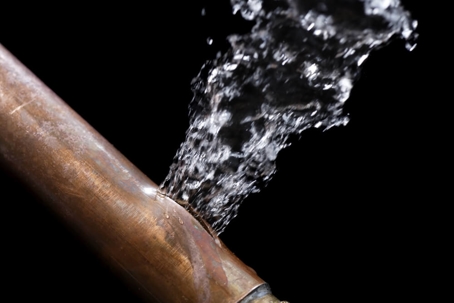If you find yourself in a plumbing situation that requires immediate action, one of the first things you do is—of course—call a plumber. You might be wondering, though, what you should be doing in the meantime, especially if water is still leaking from one of your pipes. After all, no one wants to sit back and watch the situation get worse while waiting for help.
To solve this dilemma, here are some tips for three major categories of plumbing problems to help you get the situation under control until a more professional solution is available. These categories are leaks, clogged drains, and broken water heaters.
Emergency Leak Repair
If you ever find yourself in a “plumbing pinch” with a leaking pipe, use these tips as a temporary fix to prevent water damage until your plumber arrives.
1. This is the number one emergency plumbing tip: find out where your home’s main water shut-off valve is located. If a leak occurs and you’re not sure how to turn off the closest water source, you can at least know exactly where to go to shut off the water to prevent further leaking. Usually, you’ll have to turn the valve clockwise.
2. After shutting off the main water valve, turn on all the spigots outside of your home and squirt your garden hose a couple times. This will get rid of any remaining water in your pipes that could still leak out and cause damage even after you’ve shut off the main valve.
3. Keep a “leak emergency kit” on hand. It should contain these things:
- A large bucket (about five gallons). This is just a useful item to have around the house in general. In the case of a sudden, forceful leak, a large bucket can be a godsend. If the bucket is big enough, it can also store the other items of your emergency leak kit.
- A large, deep, foil pan. This can catch leaks in areas where a bucket might be too tall to fit (ex. under the sink). Some people prefer to always keep these under their sinks’ pipes—not only because the pans can catch water from leaks but because they also make leaks easier to spot.
- Old towels or rags. These can be used to sop up water, and you can also wrap them around leaky pipes until a plumber arrives.
- Leak sealing tape or duct tape. This can be used to seal cracked pipes in a hurry.
- Teflon tape. This tape is will do the best job of temporarily sealing a leak around threaded connections.
- The contact information of a trustworthy plumber
Emergency Drain Clearing
A clogged drain might not require a plumber’s services every time, particularly if you use the tips given below. However, it’s important to keep in mind that clogs can indicate more serious problems with your home’s drain pipe system. A plunger might work at the moment, but to prevent damage from clogs and to postpone the need to re-pipe your home, professional drain clearing will be the best long-term solution.
1. Use a cup plunger for small drains. If you have a clog in one of your home’s smaller drains (such as the drains in your shower/bathtub or bathroom sink), your plunger of choice will be a normal cup plunger, which is the kind of plunger most people usually picture.
Pro Tip: When you use the cup plunger on your bathtub, you’ll need to have complete access to the drain for the plunger to work well. Unscrew and remove the cap that’s used to plug up your drain so that you can use the plunger effectively.
2. Use a forced cup plunger for clogs in toilets and large sinks. This plunger's funnel is used to apply more suctioning force down the drain than a traditional cup plunger. Keep one for kitchen use and one for bathroom use.
Pro Tip: When unclogging a kitchen sink with two drains, use two plungers. While working on one drain, cover the other drain with the second plunger. This will maximize the amount of suction you’ll be able to use to remove the clog.
Emergency Water Heater Repair
Proceed with caution around a broken water heater, as this can be the most dangerous part of a plumbing system to troubleshoot and repair.
1. Make sure you know how to turn off your water heater. If there’s ever an emergency, you’ll want to take care of this right away to prevent heat from building up inside it and causing it to overheat.
2. To turn off an electric water heater, switch it off at the circuit breaker panel first. If your unit has a plug, you can unplug it afterward.
3. To turn off a gas water heater, turn off the gas line first. It’s usually yellow, black, or striped with yellow and black. Valve handles (most often red) will frequently have an arrow that indicates which direction turns the gas line off.
Still Need Help? Call EZ Flow Plumbing for Same-Day Service!
If you have an issue with your Mesa, Chandler, or Gilbert plumbing system, don’t hesitate to contact our team here at EZ Flow Plumbing, LLC. We provide same-day service, and we are committed to providing you with a painless plumbing experience that is respectful and courteous.

